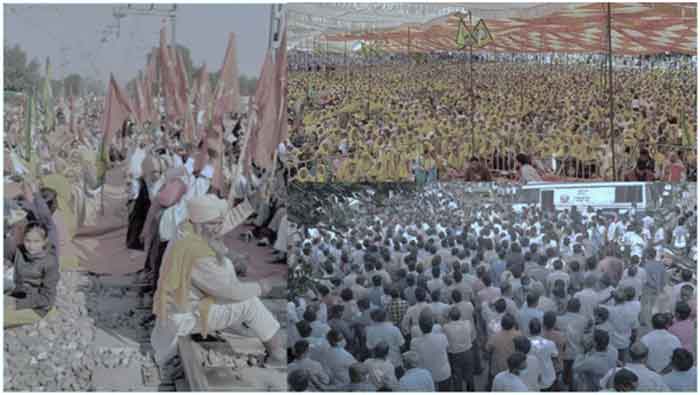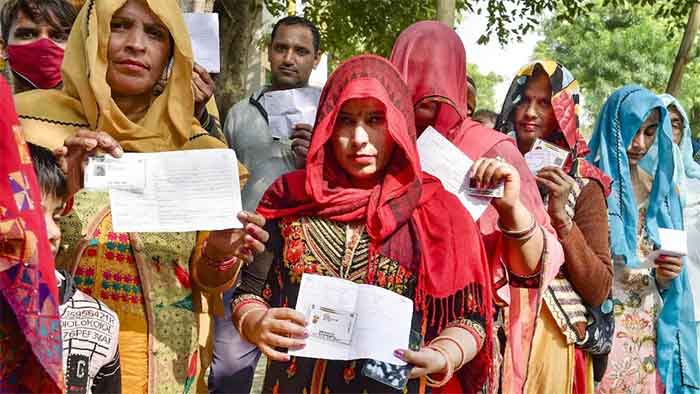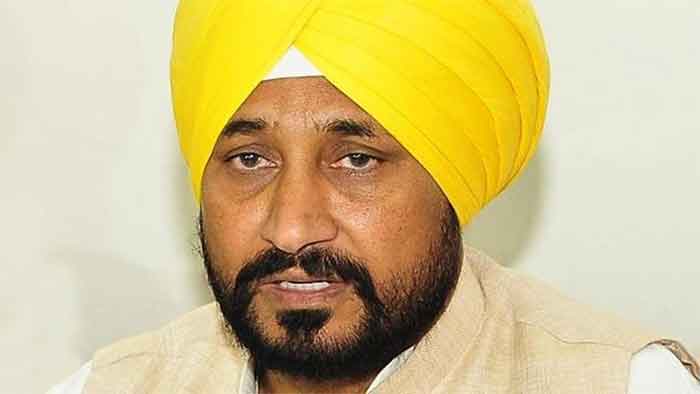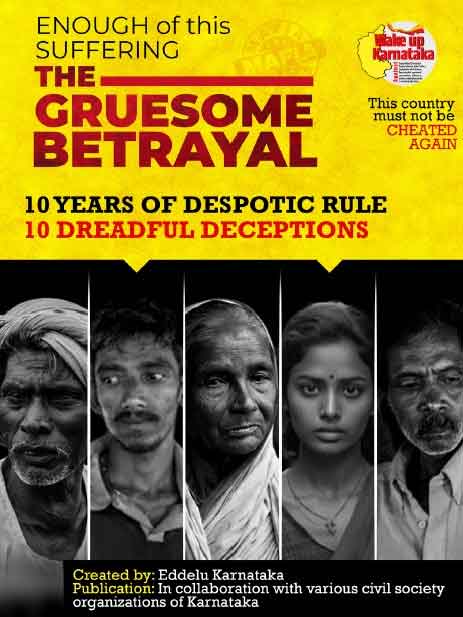
10 Weeks – In Between Returning from Delhi Border 11.12.2021 and Going to Polling Booths 20.02.2022
Millions will be waiting for the results of the elections to the five state assemblies out of which three took part in the farmers movement: Punjab, Uttarakhand and Uttar Pradesh. Gigabytes of comments from ‘Experts’ will pour out. And there will again be a grand fight of the big media houses to obfuscate and obliterate many understandings that developed from the 381 days long ‘farmers struggle’ and many stories of what happened in between fighting barricades around Delhi and polling booths spreading across states. In the above a collage of three photographs is presented – farm labourers’ strike in December (12.12.2021) a section of a mass gatherings in February, at a meeting spreading revolutionary awareness (18.02.2022) and a meeting of Striking Electricity Workers in Chandigarh (22.02.2022). Lest we forget, below is a picture of Modi’s aborted Punjab visit allegedly for ‘security lapses’ in January 2022. These are some of the reminiscences which at least a sizeable section of the masses will retain in their minds even after thunderous analyses and celebrations in virtual and real world. But these are only some of the aspects which will never be revealed by election results that will come out in coming March 10. There are many other important aspects which surely will be taken up by political activists and commentators who are far more connected with the objective reality than this author. Here we may note only a few small things which may escape attention later.

Modi’s Rally Cancelled – a photo from the National Herald 06.01.2022
What the ruling class media started to jargonise as social engineering, caste arithmetic and etc. They play with the divisions withing the toiling people. On a remarkably small happening during the farmers’ parliament march on Jan 26, 2021 when much less than 10% of the protestors could be misled in a well orchestrated move from above, we saw how the ‘Khalistani’ scream again started; even the much-famed anchor of NDTV growled for hours seeing/showing ‘insult’ of ‘national flag’ which was not factual, and did not focus on the actual farmers march that happened, how people of Delhi showed their support and solidarity towards the farmers. But the men on the top could not gauze how deep may be the wisdom of the bujurg farmers and how quickly the table was turned: divide based on caste-religion was overcome to that extent so as to carry forward the struggle (remember the lota-nun oath on Feb 7, 2021) moreover, the ‘base’ area of the struggle expanded within 10 months (e.g., Haryana SDM suspension, September 2021, Lakhimpur Kheri protest, October 2021). Towards the end of the 12½–13 months again divisive conspiracies surfaced.
Then the battle was apparently shifted to the ruler’s home ground where both the game and rules were totally different. Barricades to Booths. And why this game and its rules are difficult for toiling classes to handle is to be searched not in Punjab but in the world politics of last hundred years, which we shall visit though sparingly, later. But within these in-between 10 weeks (11.12.2021–20.02.2022) the major chunk of fighting unions, both of farmers and farm-labourers, tried their best to forge unity and break walls that separate – not only ‘indirectly’ through unity achieved through struggle, but also ‘directly’ at least in a few cases, confronting issues related to castes and religions – unity not as only a ‘by-product’ but also as a conscious endeavour to break walls. Punjab will continue to teach us rest-of-India. Issues of religion and caste were actively used by the ruling classes and their parties, but those were unable to create any outburst as planned, thanks to the vigilant farmers unions.
This patient mending of the torn social fabric, this not so manifest remoulding, will not be reported. But with this strength the unions will march forward and conspiracies will be confronted, sans doute. Note this as Point 1.
One of the most remarkable and enlightening notes on Punjab election was “Picking up the wrong battle — Why farm unions must stay out of electoral politics” by Dr Darshan Pal Singh and Harinder Happy which appeared in the Indian Express. But if this author is forgiven, this article at least in a place picked up some wrong wording. In Para 4 we find, “Being non-political was a major reason for the protest’s success.” It is surely a hurriedly written statement that may cause some dangerous notions. The writers were aware also and so ended their note with: “This is the time to stay united in the struggles against crony capitalism, neoliberal policies and communalism.” Thus, the authors tried to tell briefly the “political basis” of the unity that is needed. When we say “struggles against crony capitalism, neoliberal policies and communalism” we definitely talk about some <<politics>>. When they used the wording “non political”, it was then very contextual; they explained that too in Para 2 of their article: “Farm unions across the nation decided to remain “non-political” and did not allow political leaders on the SKM stage. This was a reflection of the frustration of the masses with mainstream political parties. The farm protests began in Punjab and were led by its farmers.” Therefore, this “non political” is a “reflection of the frustration of the masses with mainstream political parties”. If any part of SKM join the bandwagon of “mainstream political parties” and their entire politics, not only in the fight regarding parliamentary arena, but the non-parliamentary ‘fights’ of those mainstream parties and their controlled “mass organisations”, trade-unions etc, they may suffer the same fate of the mainstream parties. And the target and style of functioning of these mainstream parties and their unions percolated to others too. Had it not been initiative of some specific farmers unions of Punjab, this farmers struggle that we saw, could not have materialised. Have we not seen what the grand umbrella organisation headed by Yogendra Yadav and its constituents did in some united way or separately till 2018-19?
How far the mainstream parties can go to mislead the toiling and struggling masses can be seen from a few examples, some of their deeds and words even during the prolonged farmers’ struggle. Just one example: in his new years 2021 article Mr Yechury of CPM wrote “The demands of this protest action are completely reasonable and any rational government would have accepted it. All that is being asked from the central government is to repeal these laws now (to avoid pressures of such a possibility, amongst others, the central government cancelled the winter session of the Parliament abdicating its responsibility to be answerable and accountable) and then discuss with the farmers, the agricultural community, the corporates, all stakeholders and on that basis frame new laws and enact them in the Parliament after a structured discussion and debate.” So, the central govt was asked to repeal the three agriculture-laws, then “discuss with the farmers, the agricultural community, THE CORPORATES, All Stakeholders”, well, and then, “on that basis frame new laws”. God knows if they take “usurers” also as stakeholders, as they are so liberal-minded to take the corporates too in framing “new laws” that nobody demanded. This that CPM party leader could write even during the farmers struggle It was during their regime that contract farming was started in West Bengal with PepsiCo at lead and also foreign wholesaler Metro Cash & Carry started their operation in Kolkata. Unilever and ITC (at that time a foreign-capital controlled entity) started agricultural marketing and rural kiosks to market inputs in many states where different parties were at power. The first SEZ in the country where disputes were officially not under judicial system of the country started in West Bengal in 1980-s. People have seen the Anna movement and the fallout – the AAP experiment of populism and selective amnesia or volte-face (be that during Delhi riot or regarding AAP stand on Kashmir).
It is not for nothing that what Dr Singh and Happy wrote “frustration of the masses with mainstream political parties” evolved. Masses started learning (since 1966) from those parties that they had to “answer Bullets by Ballots”, and saw what ballots did. Most of the voters these days simultaneously put some false hope of some candidate or some party AND choose the apparent ‘lesser evil’ or ‘best among the worthless lot’. Because they have no way out and cannot think beyond parliamentary way of changing their lives, as trials of non-parliamentary or extra-parliamentary ways in the last 50+ years or 75+ years could not yet put forward some vision that the masses can cling to, including those shown de-facto by the Maoists of India and Nepal in the last 20-30 years who boycotts (or boycotted, as in the case of Nepal, before 2008) elections.
Whenever the question of ‘boycott’ comes the established communist parties jump in the debate with their theories of ‘Leninist way of participation’, nonetheless, in the last 100 years have we seen any fruition of such prolonged practice of participation other than those parties themselves getting reformed by the system, the ‘state’, to become just another law-&-order party when they ‘gain’ or slowly faded away? This becoming appendage of the system is amply demonstrated by facts like formation of Mahagutbandhan with openly pro-liberalisation parties, like deferring an all-India Workers’ Strike on the ground of election preparation in five states, and so on.
Organisations which reject the path of becoming an appendage to this system and also who are not raising any call for active boycott, are in fact are telling their support base to abstain from falling into the trap of petty-reforms and to continue the struggle and can now more successfully than before show the masses themselves how their own struggle could compel the rulers to retreat even if for just an inch and even if only temporarily.
And so, we have seen huge assemblies where farmers and farm labourers discussed ways of the alternative path. Farmers unions and farm labours unions which did not join the election bandwagon, and they were the overwhelming majority of the struggling people of Punjab are working to reinforce the strength, the strength with which the farmers could say a year ago they they were ready to stay at Delhi borders “Chaubees sal tak”, the way farmers summed up in their own way, as one answered a reporter that the main gain that farmers got was “bhaichara”. A WIRE article pointed to an apt slogan raised by BKU Ekta Ugrahan: “Votan di jhaak chhaddo, sangarshan de jhande gaddo (Stop looking for change in electoral politics, remain focused on the struggle)”. On the other hand, the ruling classes and particularly their most obedient party right now, the BJP, is keen to break this “bhaichara” and to break peoples’ resolve. They are ready to take recourse of creating rifts using irrigation water distribution issue, using Ram Rahim. However, these assembly and parliamentary elections have become a big source of distraction and it will surely dampen the spirit of the masses to some extent, in the sense of diverting their attention. The media, the internet and mobile-telephony as it is in India (for example as discussed in this article) and increasing percolation of intoxicants among the youth also do their best in this game.
And this is the second point – organisations of toiling masses based on some definite “politics” are there – who refused to tail parliamentary parties and parliament-centric or parliament-infatuated politics and simultaneously did not raise the slogan of “election boycott” – who tells the masses to rely on struggle and not on MP, MLA and so on so forth, and they are consolidating by extraordinary efforts of their activists. (By the way, the word “politics” started to be used as deception, corruption, groupism, nepotism and with all such sort of negative connotation by the media especially since the seventies of the last century to vilify the word and this, later, helped them to spread the idea of “apolitics”. In contrary, Bhagat Singh’s letter, dated Feb 2, 1931, addressed “To the Young Political Workers”; in his “Introduction to Dreamland” – book of poem by L Ram Saran Das in 1915 he writes about himself, “I, being a political worker…”.)
The third point, to write only succinctly, is that not only farmers, but also farm labourers, landless and land-hungry peasants, industrial (including utility) workers are warming up through struggles. And lastly, the last movement showed that Punjab seeds may pervade state boundary.
Whatever results March 10 may display, this built-up of peoples force from below can never be measured or shown by elections and their results. Farmers and labourers have started voting by feet. We outsiders could not even fancy that the farmers march reaching Delhi on Nov 2020 would hold the positions for such a long period, because we did not know the prolonged preparatory period. Again, we could not imagine that the movement would continue for months after that Jan 26, 2021 happenings. We shall again have to wait to see what harvest Punjab is readying, how they protect their crops from pests more dangerous than bollworms or borers.
Sandeep Banerjee is an activist who writes on political and socioeconomic issues and also on environmental issues. Some of his articles are published in Frontier Weekly. He lives in West Bengal, India. Presently he is a research worker. He can be reached at [email protected]













































